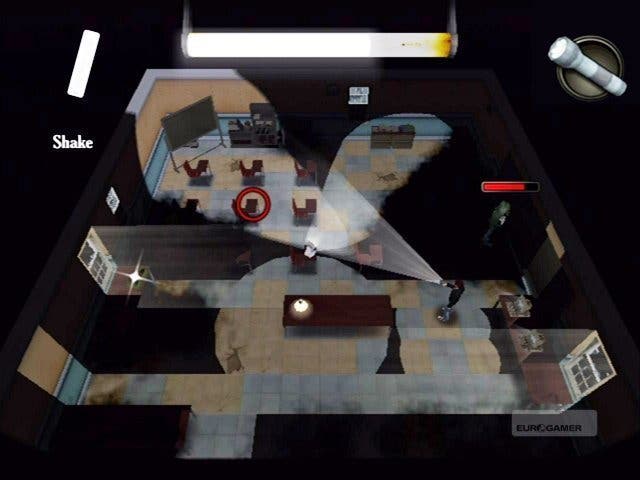LIT
Gloom with a view.
The concept for this eerie WiiWare puzzler could have come straight from a meeting of the Silent Hill school board. Our young hero - described as "emo" in the game blurb, thus saving us the effort of establishing his character - is trapped in school. At night. Oh, and the school is haunted, infested even, by a strange malignant darkness. Contact with the dark results in immediate death, as spectral hands claw through the murky miasma and pull him to his doom. There are 30 rooms of nocturnal menace to negotiate before escaping, and working out how to keep the shadows at bay forms the core of the gameplay.
Viewed from a top-down perspective, your resources are limited. To begin with, you just have a torch. Now, logically speaking, this should make things a doddle - simply point the beam of light in front of you and start walking. Having created this apparently challenge-free situation, the game then immediately bends its own reality to stop you exploiting the obvious. Yes, you can use a torch, but you can't use its light to create a safe haven from the dark.
Instead you must rely on whatever objects are in the room, using your torch to locate useful items but not to reach them. A desk lamp, for instance, creates a pool of radiance when switched on. Find slingshot ammunition and you can switch to an over-the-shoulder aiming view to break a window, letting in a shaft of much-needed light. Televisions and computers can also be used to create smaller, sometimes unreliable safe-zones. Should your torch battery run low, you must recharge it by shaking the remote - a fairly perfunctory and intrusive use of motion sensing that adds nothing to the game but inconvenience.
Electrical items use power, however, and each room has a limit to how many things can be switched on before you blow the fuse, plunging yourself back into lethal darkness. Cherry bombs, on the other hand, can be useful for breaking windows when you don't have enough slingshot ammo, but at the risk of damaging appliances that could have been more helpful.

And so it becomes a process of trial and error, cutting circles and pathways of light through the shadows to create safe passage to the exit. As well as the ill-formed spectres scuttling away from your flashlight, there's someone else in the school - your girlfriend. She'll try and make sporadic contact on the school's phones, the reaching of which forms secondary objectives as you progress. The more contact you maintain with her, the better the ending you'll get should you finally escape.
Dripping with J-horror iconography, and blessed with a clever (if slightly illogical) light-based concept, LIT would seem to boast all the ingredients required for a compelling off-beat puzzle adventure. Sadly, there are just enough rough edges to keep the game's true promise frustratingly unrealised.
Key among these is a general inconsistency in the way the rules are applied. The fuzzy line between light and dark becomes a literal matter of life or death, yet the game seems unsure as to where the line falls. Sometimes you can be dragged to your death after straying slightly from the light, at other times you'll be forced to venture so far into the grey that you should surely be killed. It's equally confusing when a tiny sliver of darkness remains between two pools of light. In one room you might be able to safely step through this barrier, in another those centimetres of shadow are instantly deadly.
Similarly problematic is the way that essential items lie just outside of the safe zones. With the aerial perspective, it's not always clear where or what items are and it's possible to put yourself in harm's way, or accidentally switch off some vital light source, while plotting your next step. It's also easy to put yourself in a hopeless situation, rendering success impossible before you've even figured out what that success requires. Throw in some ill-advised boss fights that stretch the game's engine beyond its limits, and you've got a game where trial and error is a painstaking and not always enjoyable process.
That the game manages to pull itself past these flaws is down to the strength of the concept and the earnestness of the lo-fi presentation. For all its gothic atmosphere, it's just never particularly scary. The detachment of the elevated viewpoint and the mechanical nature of the gameplay mean that you're never emotionally invested or immersed enough to feel that level of emotion.
If anything, LIT often looks and feels like a mini-game, perhaps culled from the bonus menu of some cult PS2 survival-horror like Fatal Frame or Clock Tower. Taken in those terms, there are enough ideas at work here to relegate the grumbles to secondary concerns. It's just a shame that, much like its moping hero, it never ventures far enough from its comfort zone to become truly memorable.

